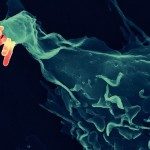Link to Pubmed [PMID] – 31851926
Link to HAL – pasteur-02557367
Link to DOI – 10.1016/j.celrep.2019.11.049
Cell Rep 2019 Dec; 29(12): 3958-3973.e7
Salmonella is a human and animal pathogen that causes gastro-enteric diseases. The key to Salmonella infection is its entry into intestinal epithelial cells, where the bacterium resides within a Salmonella-containing vacuole (SCV). Salmonella entry also induces the formation of empty macropinosomes, distinct from the SCV, in the vicinity of the entering bacteria. A few minutes after its formation, the SCV increases in size through fusions with the surrounding macropinosomes. Salmonella also induces membrane tubules that emanate from the SCV and lead to SCV shrinkage. Here, we show that these antipodal events are utilized by Salmonella to either establish a vacuolar niche or to be released into the cytosol by SCV rupture. We identify the molecular machinery underlying dynamic SCV growth and shrinkage. In particular, the SNARE proteins SNAP25 and STX4 participate in SCV inflation by fusion with macropinosomes. Thus, host compartment size control emerges as a pathogen strategy for intracellular niche regulation.








